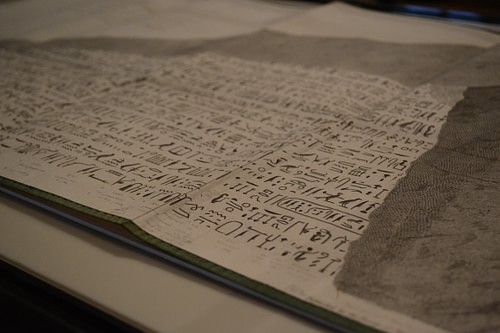During the lecture last week, I was rather intrigued by the Rosetta Stone which was inscribed with three different scripts.
The Rosetta Stone is a granodiorite steele which was part of a larger stone slab which would have stood about 2 meters in height. It was inscribed with three different scripts – Hieroglyphic script at the top, Demotic script in the middle, and the Ancient Greek language at the bottom. The Rosetta Stone was considered as the key to understanding the Hieroglyphic script, as it died out in Egypt during the fourth century CE, and the knowledge of how to decipher it was eventually lost until the Rosetta Stone was discovered in 1799.
 Image Credits: The British Museum, Claire Thorne
Image Credits: The British Museum, Claire Thorne
Hieroglyphic Script:
 Credits: The British Museum
Credits: The British Museum
- A script made up of small pictures and was used in Ancient Egypt for religious texts
- Hieroglyphic means ‘Holy Writing’ in Greek
- 3 Basic types of signs – logograms, phonograms and determinatives.
- Had over a thousand different hieroglyphs
- Can be written / read in either directions.
- Only used by a small number of priests by 196BC
Demotic Script:
 Credits: The British Museum
Credits: The British Museum
- A cursive form of Egyptian hieroglyphs
- Lack any pictorial trace
- Around 7th Century BCE.
- Represented letters and sounds that had the markings of an alphabet
- Written from right to left
- The common script for the people
Ancient Greek:
 Credits: The British Museum
Credits: The British Museum
- Written from left to right
- Egyptian pharaohs were Greek-Macedonian during then
- Brought over from Greece by rulers of the Ptolemaic dynasty
- Used by the Ptolemaic government
Three Translations of the Same Decree
The inscriptions were actually three translations of a single decree passed by a council of priests, to assert the royal cult of the then thirteen-year-old Ptolemy V on the first anniversary of his coronation in 196BC. The Hieroglyphic script were for the priests, the Demotic script for the common people, and the Ancient Greek language was for the rulers and royalty.
The decree was copied onto steeles and was placed in every temple in Egypt – the Rosetta Stone was one of the many copies.

Credits: Ancient History Encyclopedia
It was fascinating how 3 different scripts and 2 languages – Egyptian and Greek, were inscribed on the face of a large stone slab simultaneously in order for people back then to be able to understand the decree. More than a thousand years later, these inscriptions enabled us to decipher the Hieroglyphic script which would have been still otherwise lost in time, and has also enabled us to decode the other Ancient Egyptian texts and to finally be able to understand their culture and history better. Scripts were not just a way of writing and a transmission of information – they were also a reflection of the culture at that time. Similar to how the different inscriptions on the Rosetta Stone reflected the culture of the Ptolemaic dynasty in Ancient Egypt, how the Egyptian hieroglyphs fell into oblivion reflected the fall of Ancient traditional Egyptian cults and the development of new scripts and writing.
References:
http://www.byui.edu/special-collections/exhibits/rosetta-stone
https://www.ancient.eu/Egyptian_Hieroglyphs/

